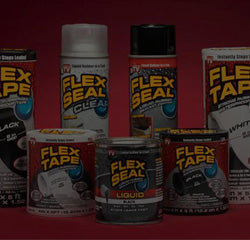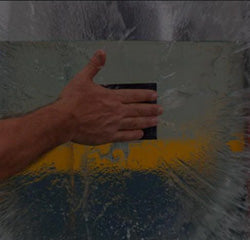9 Facts About Floods
This “Facts About Floods” blog was written by Flex Seal in collaboration with Dr. Reed Timmer.

Flooding is a worldwide problem, causing extensive damage to anything in its path. And the probability of you being affected by a flood is rising.
“Nearly all natural disasters can lead to flooding,” stresses Dr. Reed Timmer, Extreme Meteorologist and Storm Chaser. “It’s critical for everyone to understand the dangers that are associated with it.”
Timmer sat down with us to share some interesting facts about floods that should not be overlooked. Read on to learn more about flooding.
1. Floods Are Now the #1 Natural Disaster on the Planet

Floods are not only the most widespread and common natural disaster on the planet today, they are also the deadliest. Worldwide, drowning accounts for 75% of deaths during floods. These disasters are happening more frequently than ever, due in part to climate change, higher tides, and increased urban development. Canadian officials are working on ongoing measures to help their communities better navigate the impacts of flooding.
2. Earth Has Lost More Than 28 Trillion Tons of Ice Over the Last 30 Years

Rising temperatures have contributed to significant ice melts all over the planet, which is a huge cause for concern when it comes to flooding worldwide. The earth lost 1.2 trillion tons of ice in 2020 alone, and those numbers are only projected to increase in the coming years. With the ever-changing climate, flooding is becoming more frequent and even occurring in places that haven’t experienced flooding in decades.
3. Flooding Is 900% More Frequent in Coastal Areas Than 50 Years Ago

Climate change, powerful storm surges, the ability for the atmosphere to hold more moisture, and global ice melts are just some of the reasons that many coastal areas like Quebec, Ontario, & British Columbia may be seeing such an increase in sea-level rise and flooding. Even simple tidal floods, which are floods that arise from higher than usual tides, are now causing floods in areas that have not experienced them in several decades.
4. Floods Occur Year-Round

Although flooding can be more common during the summer months due to warmer temperatures, floods can, and do happen throughout the entire year. Winter storms, such as nor’easters, can cause flooding, as can ice jams and rapid snowmelts during the winter and spring seasons.
Beyond weather events, urban development, structural failures of dams and levees, and defective sewer systems can also trigger flooding at any time.
5. Flood Waters Can Sweep Away Objects That Weigh Thousands of Pounds

The power of water should not be underestimated. Just a few inches of moving water can knock someone down, and a few feet of it can carry away heavy objects, such as cars or mobile homes. Water is 1,000 times the density of air, making even a small amount of water capable of causing a large amount of destruction. Only a couple of years back, a state of emergency was declared in British Columbia due to severe structural damage, including that of municipal property. Last year, Alberta experienced a similar fate, which ultimately led to evacuations. With El Nino about to bring big moisture northward to Canada, severe weather potential is to be expected.
6. Flooding Costs Billions of Dollars in Damage Each Year

Flood water can seep into your home or business through cracks, door and window frames, or other susceptible areas. Once inside, this water can wreak havoc on your property, potentially destroying flooring, drywall, furniture and more. The excess moisture can also lead to the formation of dangerous bacteria and black mold, which can cause a host of health problems.
Basements are especially susceptible to flood damage since they are below ground level. Even small amounts of water damage from flooding can cost thousands of dollars in repair and in some cases, can even require a property to be completely gutted and rebuilt. Unfortunately, this leaves Canadian residential property owners bearing the responsibility for roughly 75% of uninsured losses.
7. Just 1 Inch of Flood Water Can Destroy a Home or Business

Flood water can seep into your home or business through cracks, door and window frames, or other susceptible areas. Once inside, this water can wreak havoc on your property, potentially destroying flooring, drywall, furniture and more. The excess moisture can also lead to the formation of dangerous bacteria and black mold, which can cause a host of health problems.
Basements are especially susceptible to flood damage since they are below ground level. Even small amounts of water damage from flooding can cost thousands of dollars in repair and in some cases, can even require a property to be completely gutted and rebuilt. Unfortunately, this leaves Canadian residential property owners bearing the responsibility for roughly 75% of uninsured losses.
8. Flood Waters Can Pose Hidden Dangers

Flood waters can be riddled with a host of dangers. Even if the water appears to be safe, it is best to avoid wading or driving through it, as there could be many hidden dangers.
Some potential dangers of flood waters include:
• Toxic waste, feces, and flesh-eating bacteria
• Wildlife, such as alligators, snakes, scorpions, spiders, and fire ant mounds
• Downed powerlines, which can electrically charge the water
• Sharp debris
• Sinkholes
9. Flex Seal Flood Protection Can Help Stop Water

Although you can’t prevent floods from happening, The Flex Seal Family of Products is revolutionizing the way you can prepare for one. Flex Seal Flood Protection is a new innovation in flood protection specifically designed to help prevent damaging flood waters from entering your home or business.
Every structure is different, making it impossible to stop all flood waters every single time, but Flex Seal Flood Protection products can help slow down or even stop water from entering your property. These incredible products work together to help create multiple layers of waterproof protection and are removable**, making them a great choice for protecting your home or business against flood water up to 3 feet or 1 meter*. They are currently available online or in stores at Canadian Tire.
IMPORTANT INFORMATION: Always follow provincial, state and local warnings regarding evacuations. Never seal people or animals inside of a structure. Every structure is different, so it's impossible to stop all flood waters 100% of the time. Depending on the age and type of construction, there may be areas that cannot be seen or sealed. Unsealed porous surfaces, such as concrete, can seep water during extended underwater exposure. Patent pending for products and uses. Not intended for flash floods.
*The Flex Flood Protection line has been evaluated by UL Solutions and meets applicable verification requirements for stopping water intrusion for the specified gap widths, water depths, specified gap widths and water depths as described here. These tests were performed in a UL Solutions laboratory using manufacturer’s recommended application instructions. ** May leave residue or remove paint. Refer to Flexseal.ca/flood for removal instructions.
By Paula Falcon
Paula is an Editor at The Flex Seal Family of Products, where she focuses on writing and editing articles for the company’s blog.








































